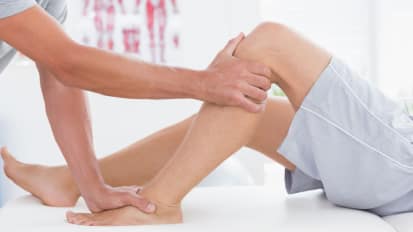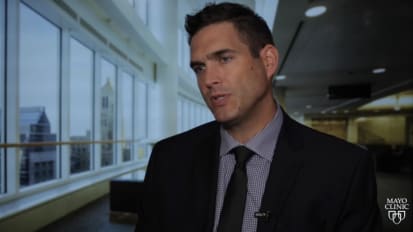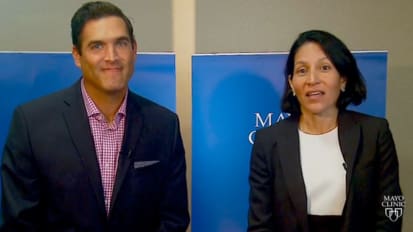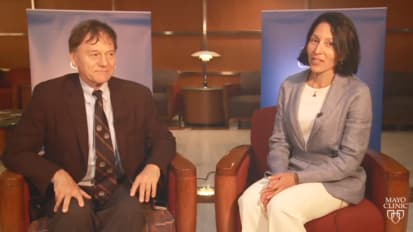Chapters
Transcript
TAMMY VOS-DRAPER: I work in spinal cord injury rehab, and part of my practice is working in the wheelchair clinic where I see a lot of patients for seating and mobility, making recommendations for seat cushions to help prevent pressure ulcers. We do see a high incidence of patients who need surgical intervention for severe ulcers.
And so, over the past few years, I've been seeing the individual stories of how those ulcers affect people, and it's pretty profound. They lose time off from work, family, things they like to do. It became very personal. And so, we tried to think of another way we could help patients manage their skin at home. Currently, the practice is to provide education on how to relieve pressure, different types of equipment to use, behaviors to use.
It's not working, and so it's not completely successful. And so, we need another tool, another way. So the solution that we came up with was a sort of biofeedback that provides a visual image of a patient's sitting surface that they can see. So patients with spinal cord injuries can't feel their bottoms, they can't feel their sitting surface. And so, this provides that biofeedback that they're missing.
They get that in the clinic. So when they come to see a therapist in a wheelchair clinic, they get pressure mapped, which is a mapping system that shows high pressure, low pressure, where it's located. And it gives them information on how they're sitting. They don't have access to that at home. The systems are very expensive, they're $8,000 to $10,000. They're designed for clinicians to look at and interpret, so the display that's showing isn't necessarily easy for a layperson, or just a wheelchair user, to interpret correctly when they're using it all day long.
And so our first goal was to figure out how to display information so that it would be relevant and useful to somebody at home. And so that's kind of how our project came about, was trying to provide another tool for people to use, in addition to what's already available. It's about 25%, at any given time, for ulcer prevalence. Once you get one ulcer, the incidence is higher for a second ulcer.
The cost per year is estimated at $6.3 billion to the health care system, just for the spinal cord injury population. So it's a very high cost, it's a really big issue that needs that needs more attention. A lot of ulcers, once they reach a certain level, there's different staging, and once they reach stage four, if they're non-healing, surgical intervention is sometimes needed. It's very expensive, it requires hospitalization, bed rest for six weeks, a lot of care.
We recommend people come in once a year for follow-up, during their annual follow-up with their PM&R physician. We try to schedule a seating clinic visit, because things can change. Their bodies are changing constantly, we like to just try to predict problems, or find problems ahead of time, before they become bigger. Sometimes I have patients who are very concerned about their skin. Maybe they have just a red area that keeps popping up, but they're not sure why, they will call me and ask if they can come in to get mapped.
And so that becomes expensive for them to have another physician, or therapist appointment, mapping. So we have people come in, they get out of their chair. We place a mat on their chair, it's about three thin layers of Spandex, with two water-resistant covers over the top, so it's stretchy. We place that over their cushion, they sit back on top of that. And then we turn on the computer, and it shows a display of their pressure.
Red is hot-- it's like a weather map, so red is hot, blue is good. We sometimes use it as education, where we say, shift your weight. And you can see how moving just a little changes your pressure. So we can use it as an education tool, as well. So with the current technology, there are inherent challenges with pressure mapping. And so, we know that when you sit for a long period on a map, or apply pressure to a pressure map, the values increase, even if the pressure doesn't increase. And that's just a challenge inherent with the map.
And so, we need to get around that somehow. And so, because we know that that's a problem, we need to use different algorithms, different ways of displaying the data that's relevant for long periods of time. And so one of our first tests was looking at that for three hours. Having somebody sit on the mat for three hours change their pressure every 30 minutes, and then observe what happens to the sensors and the data that we were receiving.
The other issue with pressure mapping is that the mat itself can cause an interaction between the user and the cushion. And so there have been a couple of studies that show that placing something between the patient and the cushion interferes with the pressure-relieving properties of the cushion. And so we needed to make sure that whatever we put on that cushion, between the patient and their cushion, was safe to sit on for long periods.
We certainly didn't want to create a new problem by adding a layer of fabric. And so then, the next step was to develop an app. And in order to do that, we first came up with what we want to display, and what do we want the app to do. And so, with the money that we had, the funding that we had in place, we were somewhat limited in that we wanted to keep it small prototype, just to show that the idea would work.
So we created a web app, which is different from a native app, on an iPhone or Android phone. It's one that you can access from the internet, and so we can access it with the iPhone. The initial app was created in a very short amount of time, but we had created wireframes of how we wanted the data to look, and then we submitted that to the software company that helped us create the coding for the app.
The tricky part was actually interfacing the app with the data coming out of the map wirelessly. So that was, probably, the most challenging piece, was combining the data that's proprietary from the company that we were using the map from. We had to work closely with that company to allow us access to that data. And once we were able to work with this company, then we were able to get the data, pull into our app, and then kind of manipulate it a little bit to display it in a different way to the user.
For the first prototype, it just works on the iPhone. And so, the software company that developed the web app, they needed to make some choices based on the funding for formatting, so they were able to format it for one type of device. And so that's one of the limitations that we have right now with our prototype. And we have five prototypes, so now we're using those in testing and in research projects.
SPEAKER 1: Five meaning?
TAMMY VOS-DRAPER: Complete mapping systems. So I have five maps with the wireless-- the little mini PC, and the wireless card, that makes it wireless. So I can have five users on the map at one time. We are in the middle of testing right now. We have a study ongoing, looking at behavior. Change. And so, we understand that just simply having the map isn't necessarily going to prevent pressure sores.
What we really hope to get at, is behavior change. And so by having that visual feedback, that biofeedback, does it help somebody move more? Does it help them change their position? Does that give them the feedback they need to make changes in how they're sitting? That's what we're really trying to get at.
Technology is fascinating, it can be cool and new, but unless it really gets at the heart of the issue by changing behavior, by changing how somebody is doing something in their daily routine, I don't know that it's very useful. The overall hypothesis, which will take a lot of work to show, is to show that we reduce the incidence of pressure ulcers nationally by providing another tool. A way for people to look at their pressure, and make behavior changes that keeps their skin healthy.
And so that's our bigger hypotheses. And, of course, it would reduce cost, so we won't be spending as much on pressure ulcer care. To get to that point, we need to do a few things. We need to show some behavior change, we need to do some smaller pilot studies to show that the map does what we think it's going to do. That it actually is helpful for people, that they would continue to use it.
So those are some of the unknowns. We don't necessarily know that somebody would continue to use this over a long period of time. I mean, we all know that the dropout rate for using wearable technology is about six months. And so, it may be a novel thing, and we want to test that. And see is this something that would really help people.
We are in the process of aligning with a couple of other organizations, to do some bigger testing, and applying for larger grant mechanisms to do that. And so that's kind of the next step, is getting more funding to do more tests and further development. And so we have plans, big plans, for developing the app further. We'd like it to do a lot more.
Providing alerts-- let's say somebody hasn't moved for 45 minutes, and that we want the map to detect that. So we want it to send a little alert, in a user-defined way. So whether it's a vibration, a sound, a quick text message, to say, you know, you haven't moved for 45 minutes, you might want to shift your weight or do an off-loading procedure. So that doesn't exist yet, but it's part of the plan.
We'd also like it to detect major changes. So let's say somebody's cushion suddenly loses air. That has been one of the issues with pressure sore development, somebody's cushion might suddenly lose air, and they don't know it. And so this may be somebody who follows all the rules. They do off-weights, they sit the way they're supposed to, they have good equipment, healthy skin. It takes one day of having a flat cushion, and it can impact their skin for a long time.
So we're trying to detect those things early on, because we know that early detection of a problem helps prevent the bigger problems, and some studies have already been done to show that. And so people who detect a stage one or stage two ulcer, can effectively prevent it from getting further along. So that's one of the goals of having a mapping system, so they can see their current live display, but also receive alerts if they need to do off-loading, or alerts if something changes, something is different from the day before.
When a pressure sore is first detected, first of all, we try to have people look at their skin every day. And that's one of the predictors of pressure sore incidents. If somebody is self-monitoring their skin regularly, that helps reduce pressure sores. So, let's say they detect a red area, a stage one. If they get out of their chair, stay out of their chair for a short period of time, let that area calm down, try to figure out what caused it. That goes a long ways to reducing it from getting bigger.
If it gets to a stage two or three, where it's open, there are different treatments that they can do. They would see their nurse, or a physician, or wound care specialist to determine which treatment would be appropriate. Stage four ulcers require a little more care. They're deeper, sometimes bigger. Once somebody gets to that point, they're usually on bed rest. If not, they're on very limited sitting protocols. And so, at this point, their life is pretty well disrupted.
They're at high risk for developing infections. Once an infection happens, then there's a risk for sepsis, and sepsis is a full-body infection, it's very challenging. And so we try to avoid that. If it develops an osteomyelitis, of course, they're looking at surgical procedures. They may shave part of the bone, they may have to take part of the bone out, and so it just becomes more serious.
I have seen ulcers heal that are very big. I've seen very large stage four ulcers heal. When somebody stays off of it, when their nutrition is good, when all the right things align and they're able to manage the pressure with all the other factors, it can heal. But the ones that don't heal are the ones that need the intervention. This is really designed to empower patients, to give them self-efficacy, to be able to be in charge of their skin care.
It's not necessarily-- I mean, it could be, but it's not being designed so that somebody can monitor them. It's being designed so that they have more control over their own care. And that, I just really wanted to emphasize, because I'm really trying to give people tools, so that they can take better care of their health.
Tamara L. Vos-Draper, O.T., occupational therapist at Mayo Clinic, discusses the problem of pressure sores and preventing them. Her team is developing a smartphone app that provides biofeedback to patients so that they might manage their skin and potential problem pressure points which helps them avoid pressure sore development.
Related Videos





